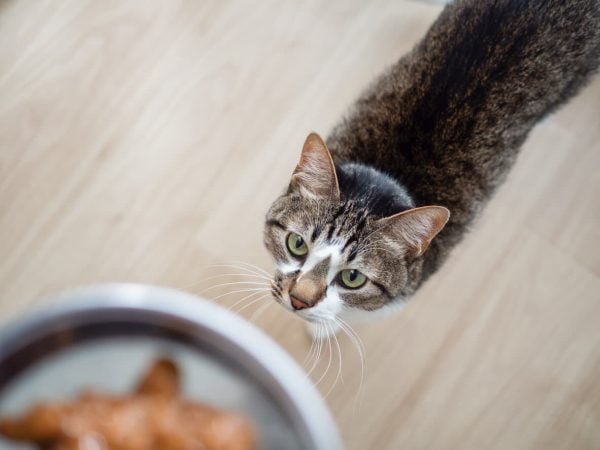- Not a substitute for professional veterinary help.
Cats can eat tuna in small amounts—but only some types of tuna. You can give your cat tuna canned in water, but avoid tuna canned in oil and tuna with added seasonings or flavors. These types may upset your cat’s stomach or even contain ingredients harmful to cats.
Tuna is packed with protein, omega-3 fatty acids, and vitamins B12 and D, and it’s perfectly safe for cats. In fact, plenty of wet cat foods contain tuna.
Cats can also eat tuna meant for humans on occasion—like when you’ve run out of their regular food and need to keep them satisfied until you can get to the store. However, they shouldn’t eat this as a regular meal, since tuna meant for humans isn’t nutritionally complete for cats.
Read on to learn more about feeding cats tuna, including which types to avoid. Plus, get ideas for other cat-friendly foods you can offer as a treat.
Why Do Cats Love Tuna?
When you open a can of tuna, you might notice your cat meowing, rubbing up against you, or trying to hop on the counter for a taste. What about tuna do cats love so much?
“Cats adore tuna primarily because of its potent aroma and high protein content, which aligns with their natural preference for meat-based diets,” says Dr. Sabrina Kong, a staff veterinarian at We Love Doodles.
“The strong smell of tuna triggers their sensitive olfactory receptors, making it irresistible. Tuna contains amino acids like histidine, which can enhance its savory appeal,” Dr. Kong says.
According to research, cats’ taste buds also contain an umami receptor that detects compounds in tuna they particularly enjoy, like histidine and inosine monophosphate.
Safe Feeding
Your cat might happily feast on tuna all day, every day. But tuna should only be an occasional treat, not a dietary staple, Dr. Kong says.
“A teaspoon of plain, cooked tuna once or twice a week is optimal and still safe,” she says.
In the chart below, Dr. Kong breaks down the different types of tuna, whether cats can eat them safely, and an appropriate portion size for cats:
| Types of tuna | Is it safe? | Portion size |
| Raw tuna | No—risk of parasites | N/A |
| Canned tuna in water | Yes | 1–2 teaspoons a week |
| Canned tuna in oil | No—risk of stomach issues | N/A |
| Seasoned or flavored tuna | No—may have unsafe ingredients, like garlic, salt, or onions | N/A |
| Cooked, unseasoned tuna in water | Yes | 1–2 teaspoons a week |
| Tuna wet food meant for cats | Yes | Check label |
| Albacore tuna | Yes, in smaller amounts due to high mercury | Limit the amount you give your cat |
| Human-grade tuna sushi or poke | No—may have unsafe ingredients, like soy sauce or wasabi | N/A |
| Tuna bones | No—risk of internal injuries due to splintering | N/A |
Does Tuna Pose Long-Term Health Risks for Cats?
The main difference between human-grade tuna and cat wet food tuna is the nutritional value. Cats can technically eat the same tuna we eat, but it isn’t formulated for their consumption or overall health.
“Human-grade tuna lacks taurine, vitamins, and minerals critical for feline health, while commercial cat food tuna is fortified to meet nutritional standards,” Dr. Kong says.
“Cat food also undergoes rigorous testing for contaminants and balances phosphorus levels, which is vital for kidney health. Human tuna may contain higher sodium and mercury, making it riskier for regular consumption,” she adds.
For example, chronic mercury exposure from eating tuna frequently can cause neurological damage in cats. For this reason, Dr. Kong recommends avoiding tuna higher in mercury, like albacore, and limiting your cat’s tuna intake in general.
Another reason to feed tuna only on occasion is the fact that it’s calorie dense. One teaspoon contains about 10 calories, which is 5% of a cat’s daily needs, Dr. Kong says. Eating too much tuna too often can lead to weight gain and obesity.
A study on common food allergen sources for pets also found that the most common food allergens for cats are beef, fish, and chicken. When giving tuna, or any other food, offer it in small amounts and monitor your cat’s reaction to make sure they don’t have an allergy.
Other Foods Your Cats Can Try
While cats can eat tuna occasionally, they can also try other foods that have more benefits with fewer risks.
If you unexpectedly run out of cat food, some foods you can give your cat as a temporary meal replacement include:
- Plain, cooked, and deboned chicken or turkey
- Cooked and unseasoned lean red meat, like beef, lamb, pork, and venison
- Eggs, boiled or scrambled with no added ingredients
- Cooked plain rice
- Canned pumpkin puree, plain with no added ingredients
“Remember, these are short-term fixes,” Dr. Kong says. “Resume a balanced commercial cat food ASAP to ensure your cat gets complete nutrition.”
If your cat likes fish, other safe fishes to offer include:
- Cooked, boneless salmon
- Sardines, packed in water with no salt added
- Cooked and deboned whitefish, like cod or haddock
- Freeze-dried minnows or salmon flakes formulated for cats
It’s always best to consult your vet to learn more about other safe foods for your cat based on their individual needs.




